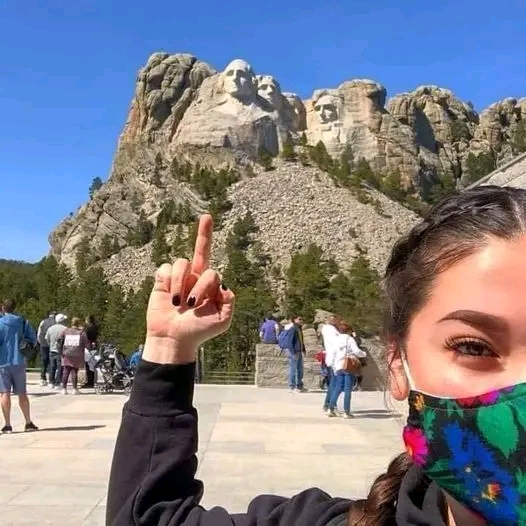
There’s a quiet truth echoing across lands that were once home, sacred, and sovereign.
It doesn’t trend. It doesn’t scream.
But when it surfaces, it hits like thunder in the soul:
“The only reason Natives visit is to do this.”
What “this” refers to has made millions stop scrolling, hold their breath, and reconsider everything they thought they knew about justice, memory, and survival. It’s not tourism. It’s not vacation. It’s not family reunions or festivals.
It’s funerals.
It’s mourning.
It’s remembering the stolen past on land that once thrived with their ancestors’ laughter, stories, and spirit.
NEVER FORGET — because for many Native communities, visiting doesn’t mean joy.
It means returning to a homeland they were ripped from, only to bury a loved one, protest desecration, or stand at the site of yet another broken promise.
A Haunting Trend Behind the Words
The phrase “The only reason Natives visit is to do this” has gone viral after a powerful social media post by a Lakota activist resurfaced. Attached to the statement was a photo of an elder standing quietly at a gravestone on a reservation, surrounded by wild prairie.
The post’s caption simply read:
“I haven’t been back in 12 years. Came home to bury my uncle. No hospital for 200 miles. No one heard him cough. The only reason we visit… is to do this. Never forget what was taken.”
Within hours, it was shared by thousands. Within days—millions.
TikTok creators, Instagram pages, and even celebrities began reposting the phrase, using it to highlight the emotional, spiritual, and geographic disconnect forced upon Indigenous communities across North America.
Land That Remembers, Even If the World Doesn’t
For many Indigenous people, their ancestral land is no longer accessible. Reservations, displacement, privatization, and centuries of colonial redrawing have turned home into a memory—not a place they live in every day.
And so when they return, it’s not for leisure.
It’s to:
Mourn a family member who died too young due to lack of access to healthcare.
Protest pipelines cutting through sacred burial sites.
Speak at ceremonies remembering boarding schools that tried to erase their language and culture.
Attend a memorial for Missing and Murdered Indigenous Women (MMIW).
Reconnect with traditions through sweat lodges or sacred rites—often only allowed during certain seasons or on restricted land.
They return with heavy hearts and heavier histories.
Generations of Erasure—But Still They Remember
Ask any Native elder what “home” means, and the answer might be everywhere and nowhere at once.
This is a direct result of government relocation programs, residential schools, land seizures, and the quiet war of cultural erasure that went on for generations.
What was once thriving nations of connected communities was deliberately fractured.
And so the visits come with sorrow, not celebration.
Because for too many, the ancestral land is:
Polluted or corporatized.
Guarded by fences.
Stripped of its original names.
Marked by gravestones instead of longhouses or tipis.
“The only reason Natives visit is to do this.”
It’s not just a phrase. It’s a grief map for generations of loss.
The Shocking Stats Behind the Silence
What’s even more gut-wrenching is that the emotional truth of that statement is backed by brutal data:
1 in 3 Indigenous people in the U.S. and Canada live off-reservation, often far from their cultural roots due to economic or social displacement.
Many reservations lack basic infrastructure—with hospitals, clean water, and schools miles or even hundreds of miles away.
Suicide rates among Native youth are more than double the national average in the U.S.
Thousands of Indigenous women remain missing or murdered—cases still unsolved, largely uninvestigated.
So yes… when they come home, it’s to mourn what never should have been lost.
The Power of Remembering
Yet in the pain, there is power.
In the visit, there is resistance.
Every time an elder lays tobacco at a gravestone, every time a drum sounds through an empty canyon, every time a Native youth returns to dance at powwow grounds carved out of hardship—the ancestors are honored.
And the world is reminded: we’re still here.
“The only reason Natives visit is to do this.”
But maybe that can change—if we listen. If we lift up Indigenous voices, histories, and sovereignty.
NEVER FORGET: This Is Not Just the Past—It’s the Present
The phrase “Never forget” is usually reserved for national tragedies.
But for Indigenous people, tragedy isn’t a date—it’s a daily reality.
And the only way forward is through truth, healing, and restoration.
Not performative land acknowledgments. Not just symbolic gestures.
But action:
Return land when possible.
Fund infrastructure on reservations.
Teach accurate history in schools.
Investigate MMIW cases with full resources.
Center Native leaders in decision-making.
Final Thought: What Will You Do After Reading This?
The quote shook the internet for a reason.
Because it wasn’t just a phrase—it was a wake-up call.
“The only reason Natives visit is to do this.”
We all have a responsibility to change the meaning of that sentence.
Let it become:
“The reason we visit is to celebrate. To reconnect. To heal. To rebuild.”
Until then…
Never forget.

Leave a Reply